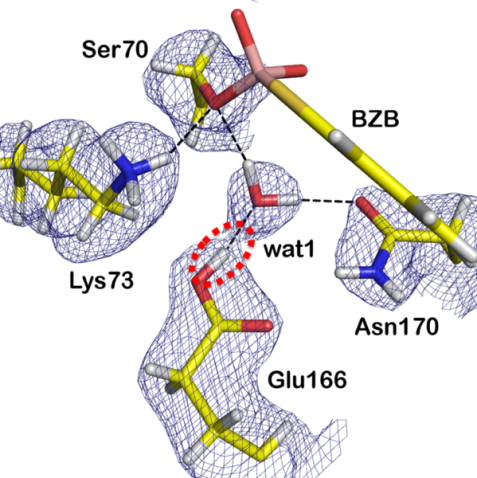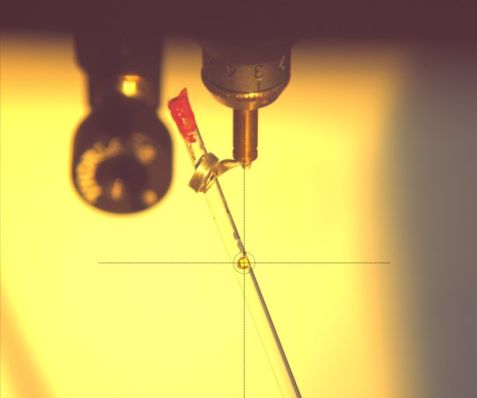MLZ is a cooperation between:
 > Technische Universität München
> Technische Universität München > Helmholtz-Zentrum Hereon
> Helmholtz-Zentrum Hereon
 > Forschungszentrum Jülich
> Forschungszentrum Jülich
MLZ is a member of:
 > LENS
> LENS > ERF-AISBL
> ERF-AISBL
MLZ on social media:

MLZ (eng)
Lichtenbergstr.1
85748 Garching
09.08.2013
Neutrons reveal mechanism of bacterial antibiotic resistance
More and more bacteria are becoming resistant to antibiotics. An example is the hydrolysis of the β-lactam ring in Penicillin and related antibiotics, thus making these drugs useless.

Result of the neutron structure analysis shown as a blue mesh and the resulting structure model. The red circle highlights the hydrogen atom (white) of Glu166. (© A. Ostermann / T. Schrader, TUM / FZ Jülich) © A. Ostermann / T. Schrader, TUM / FZ Jülich
It is still not fully understood how the enzyme beta-lactamase in bacteria carries out this process. Some important details of the reaction mechanism are still controversial. However, the understanding of this mechanism could help develop new antibiotics. Leighton Coates and co-workers from the Oak Ridge National Laboratory, USA, have now studied in detail the mechanism of a β-lactamase enzyme using neutrons at the Forschungs-Neutronenquelle Heinz Maier-Leibnitz (FRM II).
They used the diffractometer BioDiff, which is operated jointly by Andreas Ostermann (FRM II, Technical University of Munich) and Tobias Schrader (Forschungszentrum Jülich). In order to locate the hydrogen atoms in the enzyme using neutron diffraction, the researchers replaced all hydrogen atoms in the enzyme by its heavier isotope, the deuterium atom. Thus, the positions of the deuterium atoms in the active site of the enzyme could be determined, while the enzyme is bound to an antibiotics’ analogue.

The enzyme crystal, which was examined at the instrument BioDiff in a capillar. (© A. Ostermann / FRM II, TUM) © A. Ostermann / FRM II, TUM
During the reaction in the active site, a proton acceptor temporarily takes a proton. So far there have been two conflicting hypotheses, which residue acts as the general base in part of the mechanism. Numerous studies have suggested it is the Lys-73 residue, while other studies suggested the Glu-166 residue. The neutron scattering experiments at BioDiff, complemented by high-resolution X-ray analysis, however, clearly showed that the Glu-166 acts as a proton acceptor.
Original publication:
Neutron and X-ray Crystal Structures of a Perdeuterated Enzyme Inhibitor Complex Reveal the Catalytic Proton Network of the Toho-1 β-Lactamase for the Acylation Reaction
Stephen J. Tomanicek, Robert F. Standaert, Kevin L. Weiss, Andreas Ostermann, Tobias E. Schrader, Joseph D. Ng und Leighton Coates
Journal of Biological Chemistry, 288(7):4715-4722, 2013
DOI: 10.1074/jbc.M112.436238
Contact:
Dr. Andreas Ostermann and Dr. Tobias Schrader
Forschungs-Neutronenquelle
Heinz Maier-Leibnitz (FRM II),
Tel. +49.(0)89.289.14702 /-10743,
E-Mail: andreas.ostermann@frm2.tum.de and t.schrader@fz-juelich.de
Press contact:
Andrea Voit
Forschungs-Neutronenquelle
Heinz Maier-Leibnitz (FRM II)
Tel. +49.(0)89.289.12141,
E-Mail: andrea.voit@frm2.tum.de
MLZ is a cooperation between:
 > Technische Universität München
> Technische Universität München > Helmholtz-Zentrum Hereon
> Helmholtz-Zentrum Hereon
 > Forschungszentrum Jülich
> Forschungszentrum Jülich
MLZ is a member of:
 > LENS
> LENS > ERF-AISBL
> ERF-AISBL
MLZ on social media:


